Genre: RPG Developer: Sega of Japan Publisher: Sega of Japan Players: 1 Released: 1994
Some time ago, I wrote an article about how Sega’s awesome RPG Surging Aura never left its native Japan. In it, I lamented that one of the best representations of the genre on Sega’s console would never be enjoyed by the majority of Genesis owners worldwide. While I’d only played through a portion of the game before getting stuck (on something rather stupid, in hindsight), I saw enough to convince me that this was one title that I simply must play through. Language barrier or not, I promised myself that I was going to complete Surging Aura.
Fast forward a few years, and I’ve finally made good on that promise. A fellow on YouTube that goes by the name of reinofhearts made a series of videos in which he played Surging Aura from beginning to end, translating the story and adding subtitles to the cut scenes. Thanks to his thirty-two videos, I was able to not only finish the game, but understand everything about it! Again, the Internet comes to the rescue of the import gamer.
Anyone who has seen Surging Aura in action undoubtedly recognizes the engine. Reportedly, it’s made on the same one used by Phantasy Star IV, and the graphics and sound are very reminiscent of that classic adventure. However, this doesn’t mean that Surging Aura is a clone; far from it. The game has an identity all its own, and it oozes that Sega charm we all know and love from those great first party RPGs that only the House of Sonic could produce. The character designs are done by renowned artist Mutsumi Inomata, popular for her anime characters and work on Namco’s Tales series. There are also some Shining Force-like elements in the interface as well, with each character having a portrait that displays their emotions during conversations. It’s all very neat and organized, and the whole thing comes together in a way that comes off as completely new but at the same time quite familiar to Sega RPG fans.
Surging Aura presents a tale of the young light conjurer Mhu who is tasked with preventing the end of his beloved Pasphalda. On the twentieth anniversary of its founding, the realm is attacked by Lufede, a dark conjurer who had been defeated years ago in his attempts to obtain the Tome of Darkness and reshape the world back during the Holy War of Azlar. The Tome was sealed away by the four Heroes of Legend: Balan, Aurns, Mil, and Silk. Lufede was beaten and had disappeared until this brazen attack two decades later. Balan and Silk went on to rule Pasphalda as king and queen, and their son Mhu continues his studies under advisor Aurns.
Upon Lufede’s re-emergence, he assaults the castle in a bid to steal its sacred tome. After his defeat, Lufede hid and recharged his power, while seeking the other five tomes (solid, liquid, spirit, light, and will). Together, the six mystic books are the source of the world’s magic, and Lufede seeks to use them to unleash the power of the Darkness Charm and rebuild the world in his image. He steals the final tome and uses the charm, killing everyone in the process and bringing eternal darkness upon the land. However, Mhu is rescued near death by the Messenger of Time, a six-armed rabbit who sends him back to the past to stop Lufede from ever obtaining the other five tomes. Now, Mhu finds himself allied with the original heroes in their primes, and together they must prevent a horrible timeline from ever coming to pass.
On its surface, Surging Aura looks like a typical 16-bit RPG as it plays out this intriguing narrative. Players maneuver their party from town to town, leveling up and buying better equipment. The world of Pasphalda is divided into three continents, and the landscape is littered with monster-filled ruins that house the sacred books. Mhu and his party must get there before Samnibal, Lufede’s chief henchman, can steal the books away. Speaking to townspeople is not usually a requirement, and towns mostly serve only to heal and prepare, but there are instances where players must do the dance of the hero and chat with the locals to advance the story. As always, the next step is never too far, and simply talking with everyone in town should be enough to set Mhu in the right direction.
Though the visual and sound styles may not be new, they are still quite attractive. Still, I do wish that there was more variety to the look of each town and location. What’s there is nicely detailed, but environments tend to repeat themselves too often. Fortunately, battles have a bit more diversity to them (they’re fought with the background of where they take place), and there are also neat cut scenes sprinkled throughout the game. Spell effects are great, and some magic, like Zede Zede (the most powerful spell in the game), are simply incredible to behold. I wish we could have seen the party members attack, as in Phantasy Star IV, but perhaps that would have taken the similarities too far. As it is, the game is great to look at, and the characters are interesting and filled with their share of personality. Where else can you find a pirate who takes care of orphans or a warrior who’s more concerned with his looks than his own sister’s safety?
If there’s one aspect where Surging Aura succeeds in setting itself apart from Sega’s other RPG franchises, it’s in the nature of its battle system. All combat is real-time, and players must select their actions from an icon-based menu system similar in look to Shining Force. The heroes usually have the chance to go first, though foes will attack if no actions are taken. It’s important then, to get a feel for the menu system in order to react in time to anticipate attacks and counter enemy spells. Foes appear on two planes, and only magic and distance attacks (like arrows) can reach those farther back. Eliminating enemies in the first plane will bring the back ones closer, but this takes time, and many foes are adept at spell-casting. Failing to deal with them quickly can result in a party-wide magic attack.
Thankfully, this isn’t as bad as it sounds. Characters like Princess Keya can use bows, but only Mhu can use magic. For this reason, the two other members of his party must attack, heal, and defend him while he casts his spells, called “charms.” Each charm is based on one of the six types of magic powered by the tomes, and the longer the casting time, the powerful the spell, but this leaves Mhu more vulnerable to attack. If he’s hit too many times, he loses concentration and must begin casting again. Thankfully, his colleagues can take the blows for him, giving time for more powerful charms to be cast, and magical enemies are equally vulnerable to having their spells broken through attacks.
This time-consuming magic dynamic is balanced by the near instantaneous effect of healing items. Moreover, leveling up completely refills energy and magic. Everything in the menus is easy to find, thanks to the easy to read icons. The game gives you a detailed table of each charm, but this is useless unless the player speaks Japanese. The only really important thing to remember is that charms with a cast time of one are for attacking, and those with a cast time of three are for healing.
Overall, Surging Aura is an RPG that Sega fans simply need to check out. It’s only about fifteen hours long and is quite playable after one gets the hang of the menus and item names. Most importantly, with the FAQs and videos available, the game can be played through to the end, so would-be importers need not worry about getting their money’s worth. If there’s a downside to the experience, it’s remembering that this potential classic never got the chance to shine outside of Japan. Let’s do it a favor and remedy that by finally giving it the playtime it deserves.
SCORE: 9 out of 10

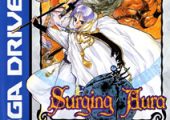
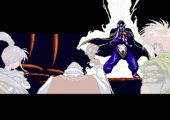
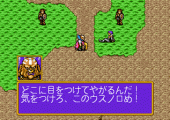
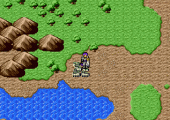
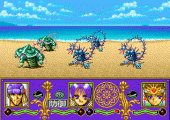
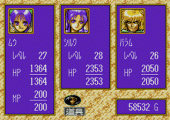
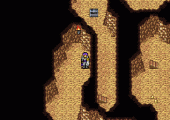
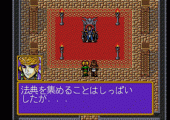
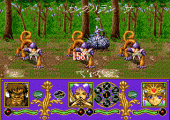
Recent Comments